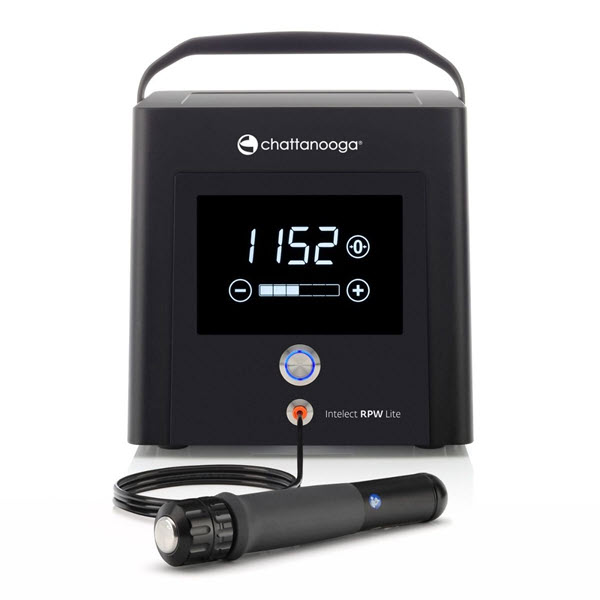
Shockwave Therapy: A Deeper Dive
Dr. Christopher Aysom, Principal Clinician
BChiroSc, MChiro (Chiropractor)
Credit to Dr. Michael Vanchieri of Wildcard Spine & Sport, for his work on this post.
In a recent article we introduced the benefits of Shockwave therapy in the treatment of chronic pain, particularly how it reduces adhesion, reduces chronic inflammation, improves tissue health, regenerates vasculature, and facilitates stem cell activity.
The purpose of this article is to understand shockwave therapy at a deeper level. Our patients frequently comment that the treatment feels great and the benefits are impressive, but the next questions is – how does it actually work? This article is a deeper dive for those that are interested to understand how this technology works and how it can help patients with chronic pain.
What is a Shockwave?
A shockwave (also known as a radial pressure wave) is a sound wave. That sound wave creates energy. Think about that feeling of vibration that a loud car speaker produces (The Italian Job features “speakers so loud, they’ll blow women’s clothes off”) or the dirt kicking up from the energy of an explosion.
The handheld transmitter contains a piston that is activated by compressed air from the main unit. As the piston rattles back and forth striking the head of the transmitter, kinetic energy is converted into vibrational sound waves much like hitting a cymbal with a drumstick. These waves travel through the ultrasound gel and into your body directed to the target tissue. The higher the frequency and amplitude of the wave, the more energy it will possess. The more energy it possesses, the deeper it will travel and the more adhesion it will break.
But how does it break down adhesion (fibrosis)?
We know that tension is needed to break down adhesion. Traditionally, we created that tension with either shear force from our hands and movement of the body, or by surface tension created by an edged tool. A shockwave creates tension through the energy from the sound wave. The combination of the frequency, amplitude, and wavelength of the wave travels through the body and oscillates a muscle, ligament, or tendon like a guitar string. With enough energy and enough length, you can create enough tension to break down adhesion.
Think of a rubber-band.
If you have a rubber-band around, soak it in water, stretch it out, and put some energy into it by flicking it. What happens to the water? It shakes out! After a couple of flicks, it’ll be almost completely dry!
We can even manipulate variables to determine how much tension we want. By increasing energy and thus frequency, we increase tension. This is like flicking the rubber-band harder. We can also increase tension by increasing the length of the targeted tissue. This is like stretching the rubber-band out further.
But how do we manipulate those variables to target only the target tissue and avoid unwanted treatment in the healthy tissue? By pre-stretching a tissue, we can decrease the amount of energy we need to put into it to create adhesion-breaking tension.
For effective treatment, we want to pre-stretch the target tissue so that the sound wave provides only enough energy to cause tension in that tissue. This allows for greater specificity with less involvement of non-target tissues.
If we circle back to the rubber band analogy, we can think of a joint as a series of rubber bands of different lengths, at different depths, traveling in different directions. The way we would knock the water off the one we wanted to would be to stretch the target band further than the others and only hit it with enough force to where that stretched rubber band produced enough tension to shake the water off.
Why is this different to using a massage gun?
It comes down to the total energy that ends up interacting with the target tissue. Shockwave has a higher energy output to treat the tissues, compared to a massage gun or other modalities, such as an ultrasound device. The overall energy that’s needed is derived from the frequency, wavelength, and amplitude of a wave. This helps explain why these other treatment modalities do not create the same effect.
Massage guns have adequate amplitude but not enough frequency. This results in energy that’s not strong enough to break down adhesion.
Therapeutic ultrasound has adequate frequency but not enough amplitude (among other things such as the waves being too uniform to deform tissue) to generate enough energy to break down adhesion. Ultrasound frequency causes a heating effect. This heating effect can be used to “warm” tissue up, but does not create enough tension to break adhesion down. Enough heat can even burn your skin.
Shockwave carries enough frequency and amplitude to reach the target tissue, with enough energy to create tension. Ideally, this is done only in the target tissue by pre-stretching it.
The end result of delivering a shockwave to a pre-tensioned target tissue is removal of adhesion (fibrosis), much more effectively and comprehensively than we’ve ever been able to do before. Not only is it more efficient, but we can now also reach certain areas that we physically couldn’t with our hands. This results in the patient getting better, faster.

If you, or anyone that you know is suffering with chronic pain that won’t go away despite everything you’ve tried so far, please consider scheduling an Initial Consultation (link below on this page).
Dr. Christopher Aysom, Principal Clinician
BChiroSc, MChiro (Chiropractor)
Apex Soft Tissue & Spine
Pymble, NSW, Australia
https://apexsofttissue.com.au




